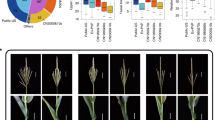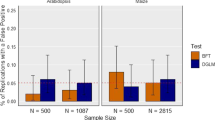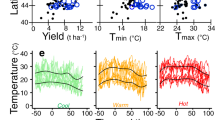Abstract
Phenotypic plasticity describes the phenotypic variation of a trait when a genotype is exposed to different environments. Understanding the genetic control of phenotypic plasticity in crops such as maize is of paramount importance for maintaining and increasing yields in a world experiencing climate change. Here, we report the results of genome-wide association analyses of multiple phenotypes and two measures of phenotypic plasticity in a maize nested association mapping (US-NAM) population grown in multiple environments and genotyped with ~2.5 million single-nucleotide polymorphisms. We show that across all traits the candidate genes for mean phenotype values and plasticity measures form structurally and functionally distinct groups. Such independent genetic control suggests that breeders will be able to select semi-independently for mean phenotype values and plasticity, thereby generating varieties with both high mean phenotype values and levels of plasticity that are appropriate for the target performance environments.
This is a preview of subscription content, access via your institution
Access options
Access Nature and 54 other Nature Portfolio journals
Get Nature+, our best-value online-access subscription
$29.99 / 30 days
cancel any time
Subscribe to this journal
Receive 12 digital issues and online access to articles
$119.00 per year
only $9.92 per issue
Buy this article
- Purchase on Springer Link
- Instant access to full article PDF
Prices may be subject to local taxes which are calculated during checkout




Similar content being viewed by others
References
West-Eberhard, M. J. Developmental plasticity and evolution (Oxford University Press, New York, 2003).
Pigliucci, M. Evolution of phenotypic plasticity: where are we going now? Trends Ecol. Evol. 20, 481–486 (2005).
Allard, R. W. & Bradshaw, A. D. Implications of genotype-environmental interactions in applied plant breeding. Crop Sci. 4, 503–508 (1964).
Bradshaw, A. D. Evolutionary significance of phenotypic plasticity in plants. Adv. Genet. 13, 115–155 (1965).
Alexandratos, N. & Bruinsma, J. World agriculture towards 2015/2030: The 2012 Revision (FAO, Rome, 2012).
IPCC Contribution of Working Group I to the Fourth Assessment Report of the Intergovernmental Panel on Climate Change (eds. Solomon, S. et al.) (Cambridge Univ. Press, Cambridge, (2007).
Bradshaw, A. D. Unvravelling phenotypic plasticity – why should we bother? New Phytol. 170, 644–8 (2006).
Ceccarelli, S. Wide adaptation: how wide? Euphytica 40, 197–205 (1989).
Wang, Y. et al. First insights into the genotype-phenotype map of phenotypic stability in rye. J. Exp. Bot. 66, 3275–3284 (2015).
Huang, M. et al. Genomic selection for wheat traits and trait stability. Theor. Appl. Genet. 129, 1697–1710 (2016).
Gillespie, J. H. & Turelli, M. Genotype-environment interactions and the maintenance of polygenic variation. Genetics 121, 129–38 (1989).
Via, S. & Lande, R. Genotype-environment interaction and the evolution of phenotypic plasticity. Evolution 39, 505–522 (1985).
Via, S. Adaptive phenotypic plasticity: target or by-product of selection in a variable environment? Am. Nat. 142, 352–365 (1993).
Scheiner, S. M. & Lyman, R. F. The genetics of phenotypic plasticity: I. Heritability. J. Evol. Biol. 2, 95–107 (1989).
Scheiner, S. M. Genetics and evolution of phenotypic plasticity. Annu. Rev. Ecol. Syst. 24, 35–68 (1993).
Wu, R. The detection of plasticity genes in heterogeneous environments. Evolution 52, 967–977 (1998).
Ungerer, M. C., Halldorsdottir, S. S., Purugganan, M. D. & Mackay, T. F. C. Genotype-environment interactions at quantitative trait loci affecting inflorescence development in Arabidopsis thaliana. Genetics 165, 353–365 (2003).
Kraakman, A. T. W., Niks, R. E., Van Den Berg, P. M. M. M., Stam, P. & Van Eeuwijk, F. A. Linkage disequilibrium mapping of yield and yield stability in modern spring barley cultivars. Genetics 168, 435–446 (2004).
Emebiri, L. C. & Moody, D. B. Heritable basis for some genotype-environment stability statistics: inferences from QTL analysis of heading date in two-rowed barley. Field Crop. Res. 96, 243–251 (2006).
Lacaze, X., Hayes, P. M. & Korol, A. Genetics of phenotypic plasticity: QTL analysis in barley, Hordeum vulgare. Heredity 102, 163–173 (2009).
FAOSTAT Crops (FAO, 2015); at http://faostat3.fao.org/browse/Q/QC/E
Chia, J.-M. et al. Maize HapMap2 identifies extant variation from a genome in flux. Nat. Genet. 44, 803–807 (2012).
Yan, J. et al. Genetic characterization and linkage disequilibrium estimation of a global maize collection using SNP markers. PLoS ONE 4, e8451 (2009).
Finlay, K. W. & Wilkinson, G. N. The analysis of adaptation in a plant-breeding programme. Aust. J. Agric. Res. 14, 742 (1963).
Su, G. et al. Bayesian analysis of the linear reaction norm model with unknown covariates. J. Anim. Sci. 84, 1651–1657 (2006).
Lian, L. & de los Campos, G. FW: An R package for Finlay-Wilkinson Regression that incorporates genomic/pedigree information and covariance structures between environments. Genes Genomes Genet. 6, 589–597 (2016).
Fripp, Y. J. & Caten, C. E. Genotype-environmental interactions in Schizophyllum commune: III. The relationship between mean expression and sensitivity to change in environment. Heredity 30, 341–349 (1973).
Lin, C. S. & Binns, M. R. A method of analyzing cultivar x location x year experiments: A new stability parameter. Theor. Appl. Genet. 76, 425–430 (1988).
Lee, E. A. et al. Involvement of year-to-year variation in thermal time, solar radiation and soil available moisture in genotype-by-environment effects in maize. Crop Sci. 56, 2180–2192 (2016).
Yu, J., Holland, J. B., McMullen, M. D. & Buckler, E. S. Genetic design and statistical power of nested association mapping in maize. Genetics 178, 539–551 (2008).
Buckler, E. S. et al. The genetic architecture of maize flowering time. Science 325, 714–718 (2009).
Rodgers-Melnick, E., Vera, D. L., Bass, H. W. & Buckler, E. S. Open chromatin reveals the functional maize genome. Proc. Natl Acad. Sci. USA 113, E3177–E3184 (2016)
Liu, X., Huang, M., Fan, B., Buckler, E. S. & Zhang, Z. Iterative usage of fixed and random effect models for powerful and efficient genome-wide association studies. PLoS Genet. 12, e1005767 (2016).
Wallace, J. G. et al. Association mapping across numerous traits reveals patterns of functional variation in maize. PLoS Genet. 10, e1004845 (2014).
Yilmaz, A. et al. GRASSIUS: a platform for comparative regulatory genomics across the grasses. Plant Physiol. 149, 171–80 (2009).
Cubas, P., Lauter, N., Doebley, J. & Coen, E. The TCP domain: A motif found in proteins regulating plant growth and development. Plant J. 18, 215–222 (1999).
Zhu, G. et al. PPIM: a protein-protein interaction database for maize. Plant Physiol. 170, 618–626 (2016).
Maere, S., Heymans, K. & Kuiper, M. BiNGO: a Cytoscape plugin to assess overrepresentation of gene ontology categories in biological networks. Bioinformatics 21, 3448–3449 (2005).
Schnable, P. S. & Springer, N. M. Progress toward understanding heterosis in crop plants. Annu. Rev. Plant Biol. 64, 71–88 (2013).
Walsh, B. & Lynch, M. in Evolution and Selection of Quantitative Traits: I. Foundations (in the press); http://nitro.biosci.arizona.edu/zbook/NewVolume_2/pdf/WLChapter17.pdf
Solovieff, N., Cotsapas, C., Lee, P. H., Purcell, S. M. & Smoller, J. W. Pleiotropy in complex traits: challenges and strategies. Nat. Rev. Genet. 14, 483–495 (2013).
Li, X. et al. Genic and nongenic contributions to natural variation of quantitative traits in maize. Genome Res. 22, 2436–2444 (2012).
Li, Y. et al. Identification of genetic variants associated with maize flowering time using an extremely large multi-genetic background population. Plant J. 86, 391–402 (2016).
Visscher, P. M. & Posthuma, D. Statistical power to detect genetic loci affecting environmental sensitivity. Behav. Genet. 40, 728–733 (2010).
Lynch, M. & Walsh, B. in Evolution and Selection of Quantitative Traits: II. Advanced Topics in Breeding and Evolution (in the press); http://nitro.biosci.arizona.edu/zbook/NewVolume_2/pdf/Chapter44.pdf
Heslot, N., Akdemir, D., Sorrells, M. E. & Jannink, J.-L. Integrating environmental covariates and crop modeling into the genomic selection framework to predict genotype by environment interactions. Theor. Appl. Genet. 127, 463–80 (2014).
Jarquín, D. et al. A reaction norm model for genomic selection using high-dimensional genomic and environmental data. Theor. Appl. Genet. 127, 595–607 (2014).
Brumpton, R. J., Boughey, H. & Jinks, J. L. Joint selection for both extremes of mean performance and of sensitivity to a macroenvironmental variable: I. Family selection. Heredity 38, 219–226 (1977).
Jinks, J. L., Jayasekara, E. M. & Boughey, H. Joint selection for both extremes of mean performance and of sensitivity to a macroenvironmental variable: II. Single seed descent. Heredity 39, 345–355 (1977).
Scheiner, S. M. & Lyman, R. F. The genetics of phenotypic plasticity: II. Response to selection. J. Evol. Biol. 4, 51–68 (1991).
Covarrubias-Pazaran, G. Genome-Assisted prediction of quantitative traits using the R package sommer. PLoS ONE https://doi.org/10.1371/journal.pone.0156744 (2016).
Endelman, J. B. & Jannink, J.-L. Shrinkage estimation of the realized relationship matrix. G3 (Bethesda) 2, 1405–1413 (2012).
Bradbury, P. J. et al. TASSEL: software for association mapping of complex traits in diverse samples. Bioinformatics 23, 2633–2635 (2007).
Wen, T. J. & Schnable, P. S. Analysis of mutants of three genes that influence root hair development in Zea mays (Gramineae) suggest that root hairs are dispensable. Am. J. Bot. 81, 833–842 (1994).
Li, S. & Chou, H. H. Lucy2: an interactive DNA sequence quality trimming and vector removal tool. Bioinformatics 20, 2865–2866 (2004).
Ewing, B. & Green, P. Base-calling of automated sequencer traces using Phred: II. Error probabilities. Genome Res. 8, 186–194 (1998).
Ewing, B., Hillier, L., Wendl, M. C. & Green, P. Base-calling of automated sequencer traces using Phred: I. Accuracy assessment. Genome Res. 8, 175–185 (1998).
Wu, T. D. & Nacu, S. Fast and SNP-tolerant detection of complex variants and splicing in short reads. Bioinformatics 26, 873–881 (2010).
Gore, M. A. et al. A first-generation haplotype map of maize. Science 326, 1115–1117 (2009).
Purcell, S. et al. PLINK: a tool set for whole-genome association and population-based linkage analyses. Am. J. Hum. Genet. 81, 559–575 (2007).
Zhao, H. et al. CrossMap: a versatile tool for coordinate conversion between genome assemblies. Bioinformatics 30, 1006–1007 (2014).
Yang, J. et al. Common SNPs explain a large proportion of the heritability for human height. Nat. Genet. 42, 565–9 (2010).
Speed, D. & Balding, D. J. MultiBLUP: improved SNP-based prediction for complex traits. Genome Res. 24, 1550–1557 (2014).
Gusev, A. et al. Integrative approaches for large-scale transcriptome-wide association studies. Nat. Genet. 48, 245–252 (2016).
R Core Team R: A Language and Environment for Statistical Computing (R Foundation for Statistical Computing, 2015).
Eddelbuettel, D. & Francois, R. Rcpp: Seamless R and C++ integration. J. Stat. Softw. 40, 1–18 (2011).
Bates, D. & Eddelbuettel, D. Fast and elegant numerical linear algebra using the RcppEigen package. J. Stat. Softw. 52, 1–24 (2013).
Allaire, J. et al. RcppParallel: Parallel Programming Tools for ‘Rcpp’ (CRAN, 2016); https://cran.r-rproject.org/web/packages/RcppParallel/RcppParallel.pdf.
Storey, J. D. & Tibshirani, R. Statistical significance for genomewide studies. Proc. Natl Acad. Sci. USA 100, 9440–9445 (2003).
Storey, J. D., Bass, A. J., Dabney, A. & Robinson, D. qvalue: q-value estimation for false discovery rate control (GitHub, 2015); at http://github.com/jdstorey/qvalue.
Lawrence, M. et al. Software for computing and annotating genomic ranges. PLoS Comput. Biol. https://doi.org/10.1371/journal.pcbi.1003118 (2013).
Shannon, P. et al. Cytoscape: a software environment for integrated models of biomolecular interaction networks. Am. Assoc. Cancer Res. Educ. B 13, 2498–2504 (2003).
Acknowledgements
We thank the Panzea group for making their genotypic and phenotypic data on the US-NAM population publically available, W. Wu for conducting the RNA-Seq experiments, C.-T. ‘Eddy’ Yeh for SNP calling and J. Yang for preparing the imputed SNPs. We also thank anonymous reviewers for helpful comments. This material is based upon work supported in part by the National Science Foundation (grant number 1027527) and the National Institute of General Medical Sciences of the National Institutes of Health (grant number 1R01GM109458-01) to P.S.S. and D.N. and to D.N., respectively. The content of this paper is solely the responsibility of the authors and does not necessarily represent the official views of the National Institutes of Health.
Author information
Authors and Affiliations
Contributions
A.K., S.S. and P.S.S. conceived the study. S.S. contributed to data collection and quality control. A.K. analysed the data and interpreted the results. D.N. provided guidance with statistical analyses. A.K. and P.S.S. wrote the manuscript.
Corresponding author
Ethics declarations
Competing interests
The authors declare no competing financial interests.
Additional information
Publisher’s note: Springer Nature remains neutral with regard to jurisdictional claims in published maps and institutional affiliations.
Electronic supplementary material
Supplementary Information
Supplementary Figure 1–6, Supplementary Table 1, Supplementary References.
Supplementary Table 2
Significant SNPs for the mean phenotype, linear plasticity, and non-linear plasticity of 23 phenotypes with their estimated effect sizes, standard errors, p-values and q-values.
Supplementary Table 3
Candidate genes for the mean phenotype, linear plasticity, and non-linear plasticity of 23 phenotypes with their genomic locations and associated SNPs.
Supplementary Table 4
Enriched GO terms from the biological process sub-ontology for candidate genes grouped by mean phenotype, linear plasticity, and non-linear plasticity.
Supplementary Table 5
Enriched GO terms from the cellular component sub-ontology for candidate genes grouped by mean phenotype, linear plasticity, and non-linear plasticity.
Supplementary Table 6
Enriched GO terms from the molecular function sub-ontology for candidate genes grouped by mean phenotype, linear plasticity, and non-linear plasticity.
Supplementary Table 7
Enriched GO terms from the biological process sub-ontology for the protein products of candidate genes and their primary predicted interaction partners for the mean phenotype, linear plasticity, and non-linear plasticity of 23 phenotypes.
Supplementary Table 8
Enriched GO terms from the cellular component sub-ontology for the protein products of candidate genes and their primary predicted interaction partners for the mean phenotype, linear plasticity, and non-linear plasticity of 23 phenotypes.
Supplementary Table 9
Enriched GO terms from the molecular function sub-ontology for the protein products of candidate genes and their primary predicted interaction partners for the mean phenotype, linear plasticity, and non-linear plasticity of 23 phenotypes.
Rights and permissions
About this article
Cite this article
Kusmec, A., Srinivasan, S., Nettleton, D. et al. Distinct genetic architectures for phenotype means and plasticities in Zea mays. Nature Plants 3, 715–723 (2017). https://doi.org/10.1038/s41477-017-0007-7
Received:
Accepted:
Published:
Issue Date:
DOI: https://doi.org/10.1038/s41477-017-0007-7
This article is cited by
-
Identifying yield-related genes in maize based on ear trait plasticity
Genome Biology (2023)
-
Partitioning the forms of genotype-by-environment interaction in the reaction norm analysis of stability
Theoretical and Applied Genetics (2023)
-
Plasticity QTLs specifically contribute to the genotype × water availability interaction in maize
Theoretical and Applied Genetics (2023)
-
Untangling the genetic control of maize plant architecture plasticity
Euphytica (2022)
-
Inferring multilayer interactome networks shaping phenotypic plasticity and evolution
Nature Communications (2021)



